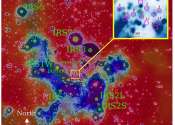Saturday Citations: Bulking tips for black holes; microbes influence drinking; new dinosaur just dropped
What did scientists do this week? Exactly four things, all of which are summarized below.

What did scientists do this week? Exactly four things, all of which are summarized below.

The James Webb Space Telescope observed a galaxy in a particularly young stage of the universe. Looking back into the past, it became clear that the light from the galaxy called J1120+0641 took almost as long to reach Earth ...
Astronomy
Jun 21, 2024
5
535

Supermassive black holes pose unanswered questions for astronomers around the world, not the least of which is "How do they grow so big?" Now, an international team of astronomers, including researchers from Chalmers University ...
Astronomy
Jun 20, 2024
0
60

Studying the history of science shows how often serendipity plays a role in some of the most important discoveries. Sometimes, the stories are apocryphal, like Newton getting hit on the head with an apple. But sometimes, ...
Astronomy
Jun 20, 2024
0
18

In late 2019, the previously unremarkable galaxy SDSS1335+0728 suddenly started shining brighter than ever before. To understand why, astronomers have used data from several space and ground-based observatories, including ...
Astronomy
Jun 18, 2024
0
154

When stars collapse, they can leave behind incredibly dense but relatively small and cold remnants called neutron stars. If two stars collapse in close proximity, the leftover binary neutron stars spiral in and eventually ...
Astronomy
Jun 18, 2024
1
802

A recent study has investigated teleparallel gravity and its potential to resolve tension surrounding the expansion of the universe in a way that general relativity can't.
Astronomy
Jun 17, 2024
7
1296

Astronomers believe that at the heart of most, if not all, galaxies sits a titanic black hole with a mass that is millions or even billions of times that of our sun. These supermassive black holes cannot be directly created ...
Astronomy
Jun 17, 2024
1
1276

Observational astronomy shows that newly discovered young stellar objects (YSOs) in the immediate vicinity of the supermassive black hole Sagittarius A* located in the center of our galaxy behave differently than expected. ...
Astronomy
Jun 14, 2024
5
524

An international team of scientists has developed a novel way to experimentally produce plasma 'fireballs' on Earth.
Plasma Physics
Jun 13, 2024
0
760
In general relativity, a black hole is a region of space in which the gravitational field is so powerful that nothing, including light, can escape its pull. The black hole has a one-way surface, called an event horizon, into which objects can fall, but out of which nothing can come. It is called "black" because it absorbs all the light that hits it, reflecting nothing, just like a perfect blackbody in thermodynamics. Quantum analysis of black holes shows them to possess a temperature and Hawking radiation.
Despite its invisible interior, a black hole can reveal its presence through interaction with other matter. A black hole can be inferred by tracking the movement of a group of stars that orbit a region in space which looks empty. Alternatively, one can see gas falling into a relatively small black hole, from a companion star. This gas spirals inward, heating up to very high temperature and emitting large amounts of radiation that can be detected from earthbound and earth-orbiting telescopes. Such observations have resulted in the scientific consensus that, barring a breakdown in our understanding of nature, black holes do exist in our universe.
This text uses material from Wikipedia, licensed under CC BY-SA